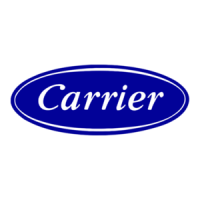60
M12 screw on bus bar, customer connection 80
Soldered screw PE, customer connection 80
Tunnel terminal screw, fuse holder Fu- 3-3.5
Tunnel terminal screw, compressor contactor KM1-->KM12 3-4.5
Brass screw M6, compressor earth EC- 5
Screw M6, compressor connection EC- 5
Tunnel terminal screw, disconnects QM- 0.8-1.2
Screw M6, earth power distribution 10
Metal screw D=4.8 Condensing module, housing supports 4.2
Screw H M8 Condensing module, compressor xing 18
Taptite screw M10 Condensing module, chassis - structure xing 30
Taptite screw M6 Piping support, cowling 7
Screw H M8 Piping clip 12
Screw H M6 Piping clip 10
Nut H M10 Compressor chassis 30
Nut M8 Plate heat exchanger xing (30RB 162-262) 12
We recommend, that finned coils are inspected regularly to
check the degree of fouling. This depends on the environment
where the unit is installed, and will be worse in urban and
industrial installations and near trees that shed their leaves.
For coil cleaning, two maintenance levels are used, based
on the AFNOR X60-010 standard:
Level 1
Recommendations for maintenance and cleaning of round
tube plate fin (RTPF) condenser coils:
• Regular cleaning of the coil surface is essential for
correct unit operation. Eliminating contamination and
removal of harmful residue will increase the operating
life of the coils and the unit.
• The maintenance and cleaning procedures below are
part of the regular maintenance and will prolong the
life of the coils.
Removal of fibres that obstruct the surfaces:
Fibres and dirt collected on the coil surface must be removed
with a vacuum cleaner. If you do not have a vacuum cleaner,
a soft brush with non-metallic bristles can be used instead. In
all cases cleaning must be done in the direction of the fins,
as the coil surface is easily damaged. The fins bend easily
and damage the protective coating of the coil, if cleaning is
done at right angles to the fins. Clean against the air flow
direction.
NOTE: Using a water jet from a spray hose on a polluted
surface will result in fibres and dirt becoming trapped in
the coil, making cleaning more difficult. All fibres and dirt
must be removed from the surface, before using a low-speed
rinsing jet.
Periodical cleaning with clean water:
For coils installed in a coastal or industrial environment
periodical cleaning by rinsing with water is beneficial. It
is however essential that rinsing is done with a low-speed
water jet to avoid damaging the fins. Monthly cleaning as
described below is recommended.
ATTENTION
• Chemical cleaning agents, water containing bleach,
acidic or basic cleaning agents must never be used to
clean the coil exterior or interior. These cleaning agents
may be difficult to rinse off and can accelerate corro-
sion at the joint between tube and fins, where two
different materials come into contact. If dirt on the
coil surface persists, use a Totaline coil cleaner as
described above.
• High-speed water from a high-pressure cleaner, spray
hose or compressed air cleaner must never be used for
coil cleaning. The force of the water or air jet will
bend the fins and increase the air-side pressure drop.
This can result in reduced performance or nuisance
shutdowns of the unit.
Recommendations for maintenance and cleaning of MCHX
(microchannel) condenser coils:
• Regular cleaning of the coil surface is essential for
correct unit operation. Eliminating contamination and
removal of harmful residue will increase the operating
life of the coils and the unit.
• The maintenance and cleaning procedures below are
part of the regular maintenance and will prolong the
life of the coils.
ATTENTION: Do not use chemical cleaners on MCHX
condenser coils. These cleaning agents can accelerate
corrosion and damage the coils.
• Remove foreign objects and debris attached to the
coil surface or wedged between the chassis and the
supports.
• Provide personal protection equipment including
safety glasses and/or a face mask, waterproof clothing
and safety gloves. It is recommended to wear clothing
that covers the whole body.
• Start the high-pressure spray gun and remove any
soap or industrial cleaner from it before cleaning the
condenser coils. Only drinkable cleaning water is
permitted to clean the condenser coils.
• Clean the condenser face by spraying the coil evenly
und in a stable manner from bottom to top, directing
the water jet at right angles to the coil. Do not exceed
62 bar or an angle of 45° related to the coil. The
diffuser must be at least 300 mm away from the coil
surface. It is essential to control the pressure and to be
careful not to damage the fins.
ATTENTION: Excessive water pressure can break the
weld points between the fins and the flat micro-channel
tubes.

